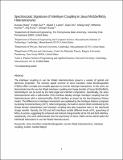Spectroscopic Signatures of Interlayer Coupling in Janus MoSSe/MoS 2 Heterostructures
Author(s)
Zhang, Kunyan; Guo, Yunfan; Larson, Daniel T; Zhu, Ziyan; Fang, Shiang; Kaxiras, Efthimios; Kong, Jing; Huang, Shengxi; ... Show more Show less
DownloadAccepted version (1.206Mb)
Open Access Policy
Open Access Policy
Creative Commons Attribution-Noncommercial-Share Alike
Terms of use
Metadata
Show full item recordAbstract
The interlayer coupling in van der Waals heterostructures governs a variety of optical and electronic properties. The intrinsic dipole moment of Janus transition metal dichalcogenides (TMDs) offers a simple and versatile approach to tune the interlayer interactions. In this work, we demonstrate how the van der Waals interlayer coupling and charge transfer of Janus MoSSe/MoS2 heterobilayers can be tuned by the twist angle and interface composition. Specifically, the Janus heterostructures with a sulfur/sulfur (S/S) interface display stronger interlayer coupling than the heterostructures with a selenium/sulfur (Se/S) interface as shown by the low-frequency Raman modes. The differences in interlayer interactions are explained by the interlayer distance computed by density-functional theory (DFT). More intriguingly, the built-in electric field contributed by the charge density redistribution and interlayer coupling also play important roles in the interfacial charge transfer. Namely, the S/S and Se/S interfaces exhibit different levels of photoluminescence (PL) quenching of MoS2 A exciton, suggesting enhanced and reduced charge transfer at the S/S and Se/S interface, respectively. Our work demonstrates how the asymmetry of Janus TMDs can be used to tailor the interfacial interactions in van der Waals heterostructures.
Date issued
2021Department
Massachusetts Institute of Technology. Department of Electrical Engineering and Computer ScienceJournal
ACS Nano
Publisher
American Chemical Society (ACS)
Citation
Zhang, Kunyan, Guo, Yunfan, Larson, Daniel T, Zhu, Ziyan, Fang, Shiang et al. 2021. "Spectroscopic Signatures of Interlayer Coupling in Janus MoSSe/MoS 2 Heterostructures." ACS Nano, 15 (9).
Version: Author's final manuscript